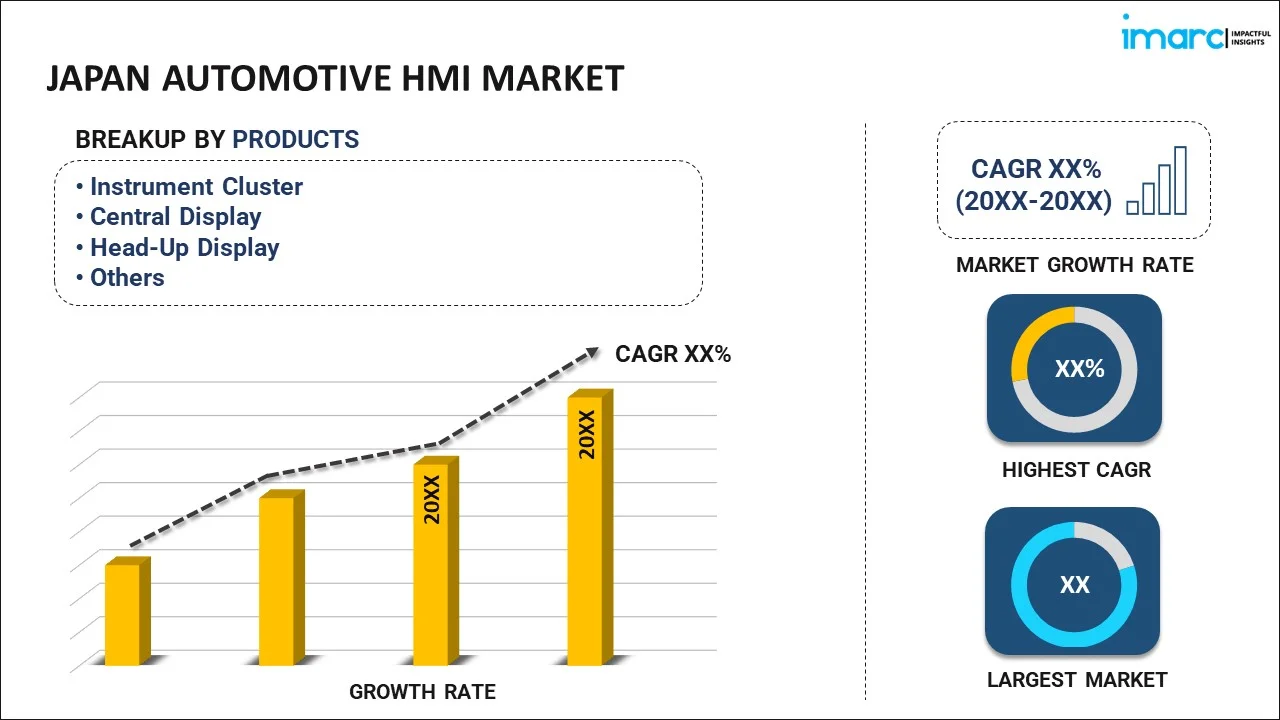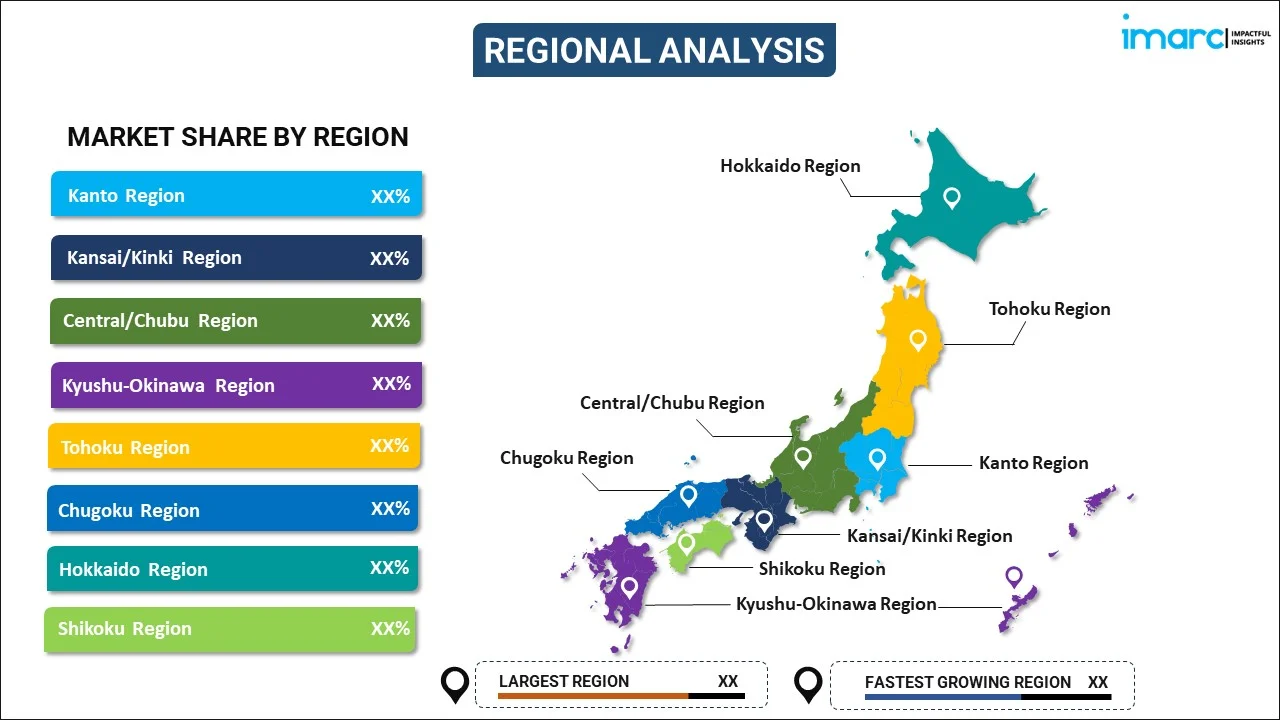
Japan Automotive HMI Market Report by Product (Instrument Cluster, Central Display, Head-Up Display, and Others), Access Type (Standard, Multimodal), Technology (Visual Interface, Acoustic, Mechanical, and Others), Vehicle Type (Passenger Cars, Commercial Vehicles), and Region 2025-2033
Market Overview:
The Japan automotive HMI market size reached USD 1.1 Billion in 2024. Looking forward, IMARC Group expects the market to reach USD 2.6 Billion by 2033, exhibiting a growth rate (CAGR) of 9.88% during 2025-2033. The rising demand for connected and autonomous vehicles (AVs), growing consumer expectations for interactive and user-friendly driving experience, the introduction of voice recognition technology, and the increasing emphasis on vehicle safety represent some of the key factors driving the market.
|
Report Attribute
|
Key Statistics
|
|---|---|
|
Base Year
|
2024
|
|
Forecast Years
|
2025-2033
|
|
Historical Years
|
2019-2024
|
|
Market Size in 2024
|
USD 1.1 Billion |
|
Market Forecast in 2033
|
USD 2.6 Billion |
| Market Growth Rate 2025-2033 | 9.88% |
Automotive human-machine interface (HMI) refers to the systems and interfaces in vehicles that allow drivers and passengers to interact with the car and its features. It is central to modern vehicle design, enhancing the user experience through intuitive controls and displays. Automotive HMIs are available in various types, such as touchscreens, voice control systems, gesture control interfaces, heads-up displays (HUD), and multifunctional steering wheels. They are manufactured from durable materials, such as high-quality plastics, glass, and sophisticated electronic components. Automotive HMIs are utilized in various applications, including navigation and infotainment systems, climate control, vehicle settings adjustments, and connectivity with smartphones and external devices. They offer numerous benefits, such as improved safety, enhanced convenience, personalized user experience, and increased accessibility. Moreover, automotive HMIs are lauded for their seamless integration, interactive and engaging environment, real-time feedback and information, and role in enhancing the overall aesthetic appeal of the vehicle's interior.
Japan Automotive HMI Market Trends:
The increasing demand for connected and autonomous vehicles (AVs) in Japan is one of the major factors boosting the market growth. In line with this, the rising need for sophisticated HMI systems that manage vehicle connections efficiently and safely are providing a thrust to the market growth. Along with this, the growing consumer expectations for interactive and user-friendly driving experience is fostering the market growth. Besides this, the integration of artificial intelligence (AI) and machine learning (ML) in automotive HMI systems, enabling personalized and adaptive interfaces, is anticipated to drive the market growth. Additionally, the introduction of voice recognition technology, allowing for natural and intuitive voice commands to enhance the ease of use and safety, is favoring the market growth. In addition to this, the increasing emphasis on vehicle safety, prompting the adoption of advanced HMI systems for minimizing distractions and making it easier for drivers to access important information, is creating a positive outlook for the market growth. Apart from this, the implementation of stringent government regulations and standards, encouraging automotive manufacturers to incorporate advanced safety features, including sophisticated HMI systems, is positively impacting the market growth. Moreover, the rising popularity of electric vehicles (EVs), featuring modern and advanced interfaces equipped with new technologies that require different types of controls and displays, is acting as a growth-inducing factor. In addition to this, the introduction of fifth-generation (5G) technology, enabling robust and responsive HMI systems to facilitate real-time data transfer and processing, is providing a considerable boost to the market growth.
Japan Automotive HMI Market Segmentation:
IMARC Group provides an analysis of the key trends in each segment of the market, along with forecasts at the country level for 2025-2033. Our report has categorized the market based on product, access type, technology, and vehicle type.
Product Insights:

- Instrument Cluster
- Central Display
- Head-Up Display
- Others
The report has provided a detailed breakup and analysis of the market based on the product. This includes instrument cluster, central display, head-up display, and others.
Access Type Insights:
- Standard
- Multimodal
A detailed breakup and analysis of the market based on the access type have also been provided in the report. This includes standard and multimodal.
Technology Insights:
- Visual Interface
- Acoustic
- Mechanical
- Others
The report has provided a detailed breakup and analysis of the market based on the technology. This includes visual interface, acoustic, mechanical, and others.
Vehicle Type Insights:
- Passenger Cars
- Commercial Vehicles
A detailed breakup and analysis of the market based on the vehicle type have also been provided in the report. This includes passenger cars and commercial vehicles.
Regional Insights:

- Kanto Region
- Kansai/Kinki Region
- Central/ Chubu Region
- Kyushu-Okinawa Region
- Tohoku Region
- Chugoku Region
- Hokkaido Region
- Shikoku Region
The report has also provided a comprehensive analysis of all the major regional markets, which include Kanto Region, Kansai/Kinki Region, Central/ Chubu Region, Kyushu-Okinawa Region, Tohoku Region, Chugoku Region, Hokkaido Region, and Shikoku Region.
Competitive Landscape:
The market research report has also provided a comprehensive analysis of the competitive landscape. Competitive analysis such as market structure, key player positioning, top winning strategies, competitive dashboard, and company evaluation quadrant has been covered in the report. Also, detailed profiles of all major companies have been provided.
Japan Automotive HMI Market Report Coverage:
| Report Features | Details |
|---|---|
| Base Year of the Analysis | 2024 |
| Historical Period | 2019-2024 |
| Forecast Period | 2025-2033 |
| Units | Billion USD |
| Scope of the Report | Exploration of Historical and Forecast Trends, Industry Catalysts and Challenges, Segment-Wise Historical and Predictive Market Assessment:
|
| Products Covered | Instrument Cluster, Central Display, Head-Up Display, Others |
| Access Types Covered | Standard, Multimodal |
| Technologies Covered | Visual Interface, Acoustic, Mechanical, Others |
| Vehicle Types Covered | Passenger Cars, Commercial Vehicles |
| Regions Covered | Kanto Region, Kansai/Kinki Region, Central/ Chubu Region, Kyushu-Okinawa Region, Tohoku Region, Chugoku Region, Hokkaido Region, Shikoku Region |
| Customization Scope | 10% Free Customization |
| Post-Sale Analyst Support | 10-12 Weeks |
| Delivery Format | PDF and Excel through Email (We can also provide the editable version of the report in PPT/Word format on special request) |
Key Questions Answered in This Report:
- How has the Japan automotive HMI market performed so far and how will it perform in the coming years?
- What has been the impact of COVID-19 on the Japan automotive HMI market?
- What is the breakup of the Japan automotive HMI market on the basis of product?
- What is the breakup of the Japan automotive HMI market on the basis of access type?
- What is the breakup of the Japan automotive HMI market on the basis of technology?
- What is the breakup of the Japan automotive HMI market on the basis of vehicle type?
- What are the various stages in the value chain of the Japan automotive HMI market?
- What are the key driving factors and challenges in the Japan automotive HMI?
- What is the structure of the Japan automotive HMI market and who are the key players?
- What is the degree of competition in the Japan automotive HMI market?
Key Benefits for Stakeholders:
- IMARC’s industry report offers a comprehensive quantitative analysis of various market segments, historical and current market trends, market forecasts, and dynamics of the Japan automotive HMI market from 2019-2033.
- The research report provides the latest information on the market drivers, challenges, and opportunities in the Japan automotive HMI market.
- Porter's five forces analysis assist stakeholders in assessing the impact of new entrants, competitive rivalry, supplier power, buyer power, and the threat of substitution. It helps stakeholders to analyze the level of competition within the Japan automotive HMI industry and its attractiveness.
- Competitive landscape allows stakeholders to understand their competitive environment and provides an insight into the current positions of key players in the market.
Need more help?
- Speak to our experienced analysts for insights on the current market scenarios.
- Include additional segments and countries to customize the report as per your requirement.
- Gain an unparalleled competitive advantage in your domain by understanding how to utilize the report and positively impacting your operations and revenue.
- For further assistance, please connect with our analysts.
 Request Customization
Request Customization
 Speak to an Analyst
Speak to an Analyst
 Request Brochure
Request Brochure
 Inquire Before Buying
Inquire Before Buying




.webp)




.webp)












